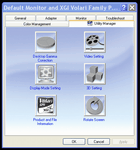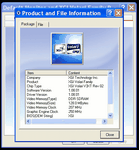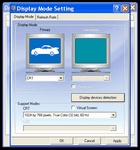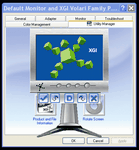| 128MB XGI Volari V3XT AGP Card - Page 3 of 7 |
Software:
XGI refers to the unified drivers for their cards as Reactor Drivers... I guess everyone needs a catchy name for drivers. The card shipped with the 1.06.05 Reactors on a CD, but the 1.08.01 version was released on January 07, 2005 and they were downloaded for the review.
The screen shown below is added to the Display Properties section of Windows, and provides a simple, uncluttered interface to the controls. In addition to the main screen, a few of the lower level screens will be shown to detail that the uncluttered look and feel are found through out.

The below left screen shot is of the "Product and File Information" tab and gives the basics of the hardware and software. of interest is that at default speed the memory is actually running 7 MHz faster than what Hynix specifies for these modules! The "Display Mode Settings" tab is shown below, and allows for basic controls such as resolution, refresh rate, and monitor type selection.
 
The below left screen shot shows the "Rotate Screen" tab. This tab has a different layout, as it is actually transparent (if it were to be dragged off of the main menu. It allows the display to be rotated, which is particularly helpful for those with LCD monitors hanging in non-standard orientations. The below right screen shot shows the "Desktop Gamma Correction" tab, which allows for fine tuning of the colors output to the display.
 
Overall I like the Reactor Driver look and feel, as it is far easier to navigate than the overly complex interfaces found in other manufacturer's software. But, one reason it may be simpler is that there aren't as many features as you might expect to find in the drivers put out by nVidia or ATI, for example. The reactors are still fairly young, and in addition to being refined for performance, one would hope that they are being refined for function.
Test Setup:
The XGI Volari V3XT was tested on a system with the specifications listed below. This card is ideally suited for an HTPC setup, so that is where it was installed...
• Intel Celeron D 2.66 GHz processor
• FoxConn 865M01-G-6LS mATX motherboard
• 512MB (2x256) GeiL PC3200 DDR memory (dual channel)
• 40GB Maxtor ATA-133 hard drive
• ATI HDTV Wonder tuner / capture card
• 17" TFT LCD monitor and 27" television
• Windows XP Professional with Service Pack 2
• DirectX 9.0c
For comparison purposes, the XGI Volari V3XT was put head to head with the HTPC's usual video card, a 64MB MSI GeForce4 MX440, as well as two more modern cards, a 128MB Sapphire Radeon 9600 and a 256MB BFG Technologies GeForce FX5500 OC. Checking the specifications of the V3XT tells me it may not be fair to compare it to the 9600 and 5700 OC, but the results should be more favorable than if compared to some of the true high end cards available today. A good point of reference will be established though, as these are now middle of the road cards featuring GPUs from ATI and nVidia.
Comparison with the MX440 card should be fair, as it will show what benefits can be achieved by upgrading to a DirectX 9 compliant card, with other interesting features, that is still in the same general price range.
The drivers used for testing included the following:
• XGI Volari V3XT - Reactor Driver 1.08.01
• Sapphire Radeon 9600 - ATI Catalyst Driver 4.12
• MSI GeForce4 MX440 and BFG Tech 5500 OC - nVidia ForceWare 66.93
Please read on to the next page for more... Next
Page 1 | Page 2 | Page 3 | Page 4 | Page 5 | Page 6 | Page 7 | Home | Forum | Review Index
|
|
|
|